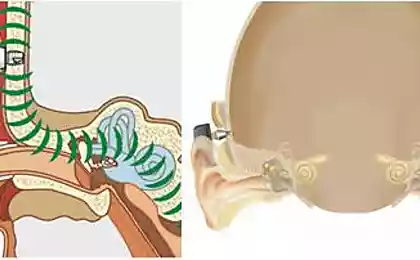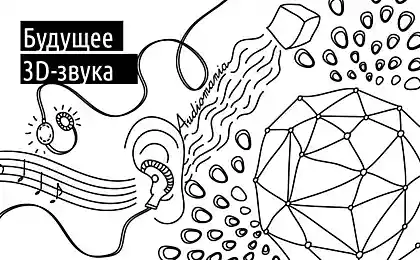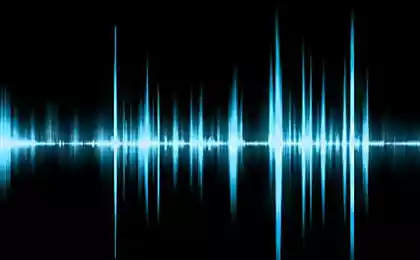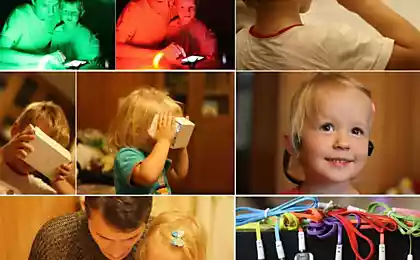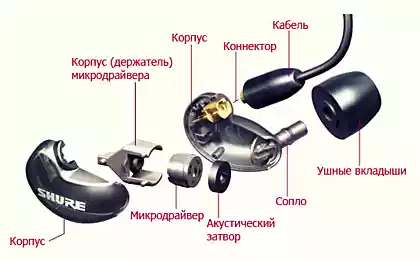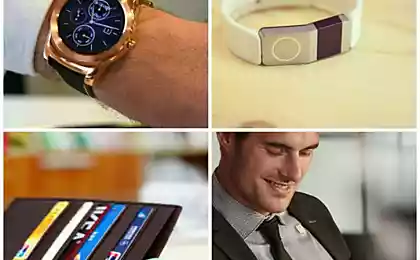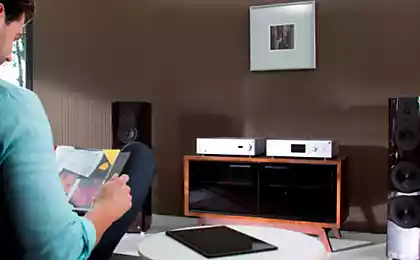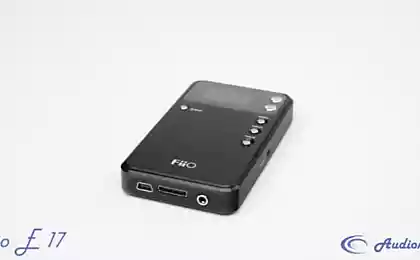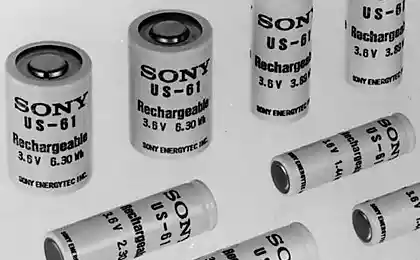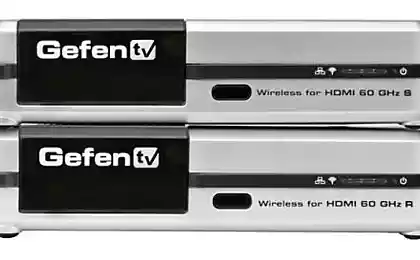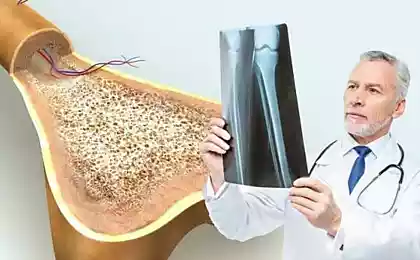1857
Aftershokz and other devices to bone conduction sound
Hearing loss - a large and important issue, given that a century of research, but so far almost every case should be considered individually on the specific cause to a particular investigation, of which there are countless. However, a few years ago Google Glass «revived" the concept of bone conduction, and today I would like to very briefly recall it in connection with headphones Aftershokz.
I'll start from the image, which shows schematically our sound-conducting system and formally everything I need to know about it: I have three ear, outer, middle and inner, and each of them is at risk. At the same time statistics on sensorineural hearing loss, unfortunately, over 70%, and therefore the problems of people with damage to the outer and middle ear for a long time as it was in the second term.

bone conduction devices
In most cases, when it comes to hearing aid, before your eyes still picture appears ITE or BTE devices, which convert the acoustic signal into an electric and back, amplifying it. However, in some cases, the use of such a device is meaningless.

And if the sound-conducting system is broken at the level of the outer and middle ear, then doctors may recommend hearing aids with bone conduction. Of course, without consultation with the hearing care professional and research audiometer, it is better not to test on itself any device! On a normal audiogram threshold in this case will be a high threshold when the air carrying the sound and normal perception of sounds of bone, in contrast to the neurosensory disorders. Rinne test in the case of conductive hearing loss will be negative if the fork longer be heard through the bone rather than "in the air».
Technology bone conduction of sound opened long ago, received the Nobel Prize, and to understand that people with a conductive hearing loss can live a normal life and work, we can recall Beethoven: he was finishing his quartets when he was seriously ill, and as a tool used wooden sticks, clenched between the teeth .
In the book, Butler "Music and Medicine" states that the disease first struck the composer accompanied by the loss of high tones and painful perception of loud sounds, but at the same bone conduction persisted, so we are pleased now listen to, for example, this kind of music.
The 15th Quartet Beethoven, 1825. The composer was already seriously ill i>
"Dental method", which used a genius, later reviewed, described, and an outstanding scientist Békésy later proved pattern between the lower jaw and the bone conduction of sound, and in our time, such studies are in the United States. In particular experiment described in the journal "Special Care in Dentistry" it shows that among 000 patients more than 1 bone conduction was inferior in humans with fewer teeth. All in all, the experiment was attended by 5, 3 percent - had no teeth; 15, 4 - have at least 17 teeth.
Diagnosis shows that devices with bone conduction may be appointed in such cases:
Bilateral atresia passage Bilateral chronic suppurative otitis media Postoperative mastodialnye large open space Inflammatory processes in the outer system < /
Bone aids convert sound into vibrations transmitted to the hard tissues of the skull, where - to the cochlea of the inner ear.
The shape of these hearing aids were different, and some sensors can be located even on the bow points, but not all implantable devices may be accompanied by painful sensations due to pressure exerted by the headband of "gadgets".
There is also a downside can be attributed:
Vibrators did not have a broadband frequency response The situation was not an implantable sensor is not fixed, changed and becomes difficult to hear Pocket hearing aids accompanied by additional noise, provoked by the friction of clothes < / The size and appearance
So long in fact, a monopoly on the market were hearing aids bone BAHA, the study of which, in particular, in the journal "Clinical otolaryngology" can be found since the mid-1990s.
They might be inconspicuous and almost did not give health problems, but the process is "integration" of such a device was not fast.
BAHA devices multipart processor, "adapter" and "Pin", which was implanted in the skull, which was possible due to "getting on with everyone," bone and titanium open Professor Brånemark.
Sound processor transformed, process and enhanced the acoustic vibrations The intermediate part has transformed into mechanical acoustic vibrations and send them forth The titanium pin transmit these vibrations to the cochlea.
This integration of hearing aids took place in two stages: the implantation of a titanium pin and six months (during which time he grows together with the bone) "hanging" of the processor.

Complications were! Could be an infection, could be damaged by hard tissues could inflame surrounding tissue and cause the pocket, which made the implant moving, and among the most frequent: inflammation of the skin around the pin.

However, neither this nor the tests in the medical journals, not stopped people. By the way, many times repeated experiments have proved very convincing "superpowers» BAHA and non-universality. This conclusion comes in 1999 in the same "Clinical Otolaryngology," later today, researchers JL Colquitt, E. Loveman, D.M. Baguley and others, referring to previous experience, spoke about the advantages of such devices in some cases, before the "air". In the journal "Laryngoscope" in 2015 it states that in spite of the enormous previous experience, research is not enough, and they should continue.
Thus, if you look at the 10 years - 15 ago, the comparative table of hearing aids with bone conduction of sound could be so.
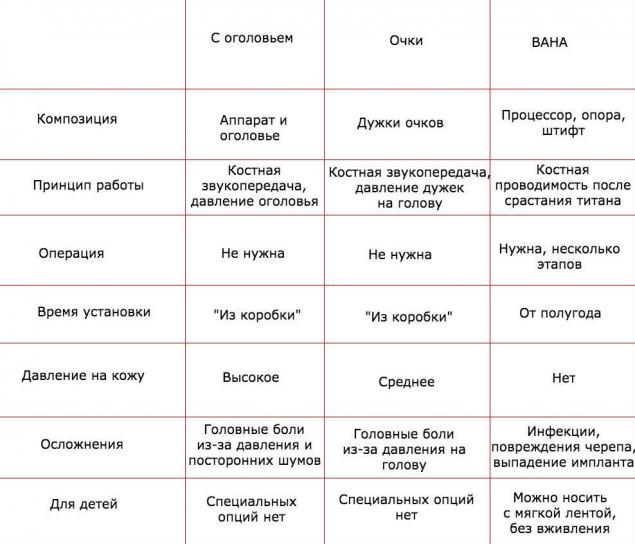
On a similar principle to the BAHA work and more modern digital hearing aids Alpha, they also implanted, but provide opportunities in terms of noise reduction and so on. N.
It is worth adding that in 1990 the doctor GG Browning believed implantable hearing aids with bone sound transmission may be relevant not for each threshold of bone conduction.
Today's research, which have become more point, "target" considering all options dependencies and causal relationships that can trigger hearing loss. Thus, despite the fact that the human inner ear is "less secure" because first of all formed, on the 4 th week of pregnancy, intrauterine deafness occurs only in 13% of cases, and immediately after birth - 59% of cases.
Modern researchers, for example, Pascal Dolle and Raymond Romande in 2006 in the pages of the "Journal of Neuroscience" clarifies that in many ways the forerunner of hearing impairment is the lack of retinol (vit A) in the body, but, of course, in the morphogenesis of the inner ear is affected not only in the absence of desired amount of a vitamin.
Also, there is the role of mutations in the gene GJB2, which encodes a transmembrane protein connexin 26, participates in cell-cell contacts in the tissues of the inner ear, however, is the frequency of congenital sensorineural hearing loss associated with this gene 1: 1000 births.

GJB2 i>
A special role is removed and hearing problems in geriatrics. In a number of publications is stated that such an obvious cause of hearing loss is aging, prevents many put up with it in old age. Dr. Allan Sinclair in his work says that this gives rise to a much more serious problem: elderly people sink into depression, and there are cases of suicide attempts!
The fact that the problem is massive and global, can speak, for example, and this collective work of Dr. Adriaan Moelker, Ronald AJJ Maas, Mohamed Ouhlous. Their study focuses on the influence of MRI devices in the sound-conducting system of the person. The study was conducted in 2005, 10 years ago.
The arms Google
Interest is a bone conduction glasses Google was excited journalist who complained that the glasses are not very suitable for people with disabilities. At the same time, it seems, and it did not cost anything to expect from the fact that his auditory system had lesions in the inner ear, and so little bone conduction could be useful to him.

However, Google has demonstrated this technology again and showed that it is now in some cases, moreover, it is not necessary to drill the skull and wait six months "implantation" of titanium, but it is not necessary to pay for it (at the time) 200 000 rubles our money for the machines BAHA! On the other hand, not everyone was comfortable to wear glasses, and not everyone needs, but small and proud Aftershokz, which at the moment seems to be lacking in its authority to shout out loud, excited. And a year later came the real flowering of hundreds of references in the press.
However, despite the fact that even the logo Aftershokz hinted at hearing, they have built an advertising campaign for a different strategy.
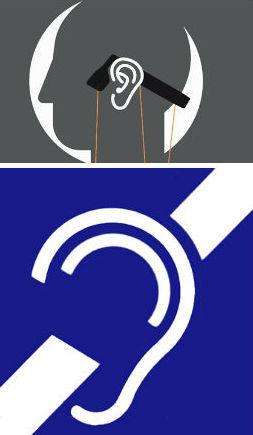
Aftershokz press
In the international and domestic press "Aftershokz" increasingly appear as headphones for sports, if you believe the headlines in Mashable, «Los Angeles Times", in English "The Independent», «techlicious», «Men'sHealth» and private surveys.

There is a reason, and today called Aftershokz headphones safe for athletes, especially for cyclists: the headphones do not close your ears, so people can hear ambient sounds, car horns, and so on. N.
This is supported by the international statistics on the number of accidents involving bicycle. In particular:
UK - 2013
19 438 accidents involving bicycle Heavy injured 2867 adults light - more than 14 thousand adults For the year on the roads accident killed 6 children and 103 adults
In the United States in 2012 killed more than 700 cyclists.
Among the most common fatal injuries in the lead head injury.
For the same period in Moscow show 271 accidents involving bicycles, which killed 2 dead (1 child), with serious injuries of 11 people (2 children).
In this sense, Aftershokz - an absolute breakthrough, because "Sliding" headphones over his ears and did not allow an increase in the volume of this perception, and plus to all, the headphones have a microphone, so that many people simply use them as a means of communication.
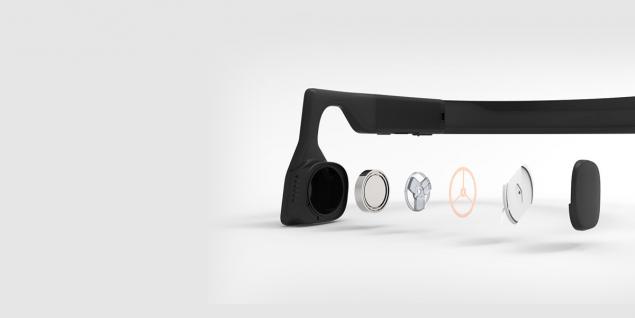
Judging by the reviews, a certain vibration, which is logical for a bone conduction device, many people do not give rest for a while, but it very quickly became accustomed. Or were brought.
My client
Unfortunately, to date, I have only theoretical understanding, which in some cases with hearing possibilities Aftershokz be useful. The only hitch now is to review the client who took our headphones to their grandfathers.
I quote verbatim:
«With headphones everything is fine - the first test was a great success. Without any additional devices grandfather without hearing aids may be tolerable to chat on the phone, that for them is quite amazing. That is, connect the headphones as a headset to the phone and everything - my grandfather could talk on the phone and hear quite well ». I>
And in the second letter:
«The most curious that one of my grandparents - is almost completely deaf in one ear only hears, and that only 5-10% compared to a healthy person. But even he had heard enough, we talked to him on the phone, which means that he is already able to walk with a mobile phone and answer in which case, and besides, at the same time it can wear your hearing aid.
Another grandfather hears much better, although much weaker than a healthy person. On the phone with him, however, it was not possible to talk - he could not hear what I answer him, and yesterday I just feel that it is well I hear, almost like a normal person.
Conventional headphones, put on the hearing aid, a hearing did not give any of my grandfathers. And these headphones work, firstly, without interaction with a hearing aid, and, secondly, to make it possible not to remove the hearing aid that is put on headphones and hearing aids and do not interfere with each other! » I>
It writes habrovchanin, and we continue to communicate with him on this matter, but so far without any concrete details.
Specifications Aftershokz:
Type of speakers: transducers for bone conduction Frequency response: 20 Hz - 20 kHz The sensitivity of speakers: 100 ± 3dB Sensitivity Microphone: -40 ± 3 dB Version Bluetooth: 2.1 + EDR Compatible profiles: A2DP, AVRCP, HSP, HFP The range of connection: 10 m < / Battery Type: Li-ion Time: 6 hours Standby time: 10 days Charging time: 2 hours black Weight: 41 g
* Please, if, God forbid, you or your loved ones have roughly described symptoms, before buying headphones or other Soup described in this article, consult your doctor. Aftershokz - headset, and are hearing aids, do not possess a medical certificate. I>
** If you are in Moscow and are willing to come to the office, you can test your headphones: we always have a sample! I>
*** If you buy Aftershokz as headphones for sports, do not forget the code «Geek», which gives 7% percent off any purchase. I>
Take care of yourself!
Buy Aftershokz
Source: geektimes.ru/company/medgadgets/blog/249492/
I'll start from the image, which shows schematically our sound-conducting system and formally everything I need to know about it: I have three ear, outer, middle and inner, and each of them is at risk. At the same time statistics on sensorineural hearing loss, unfortunately, over 70%, and therefore the problems of people with damage to the outer and middle ear for a long time as it was in the second term.

bone conduction devices
In most cases, when it comes to hearing aid, before your eyes still picture appears ITE or BTE devices, which convert the acoustic signal into an electric and back, amplifying it. However, in some cases, the use of such a device is meaningless.

And if the sound-conducting system is broken at the level of the outer and middle ear, then doctors may recommend hearing aids with bone conduction. Of course, without consultation with the hearing care professional and research audiometer, it is better not to test on itself any device! On a normal audiogram threshold in this case will be a high threshold when the air carrying the sound and normal perception of sounds of bone, in contrast to the neurosensory disorders. Rinne test in the case of conductive hearing loss will be negative if the fork longer be heard through the bone rather than "in the air».
Technology bone conduction of sound opened long ago, received the Nobel Prize, and to understand that people with a conductive hearing loss can live a normal life and work, we can recall Beethoven: he was finishing his quartets when he was seriously ill, and as a tool used wooden sticks, clenched between the teeth .
In the book, Butler "Music and Medicine" states that the disease first struck the composer accompanied by the loss of high tones and painful perception of loud sounds, but at the same bone conduction persisted, so we are pleased now listen to, for example, this kind of music.
The 15th Quartet Beethoven, 1825. The composer was already seriously ill i>
"Dental method", which used a genius, later reviewed, described, and an outstanding scientist Békésy later proved pattern between the lower jaw and the bone conduction of sound, and in our time, such studies are in the United States. In particular experiment described in the journal "Special Care in Dentistry" it shows that among 000 patients more than 1 bone conduction was inferior in humans with fewer teeth. All in all, the experiment was attended by 5, 3 percent - had no teeth; 15, 4 - have at least 17 teeth.
Diagnosis shows that devices with bone conduction may be appointed in such cases:
Bilateral atresia passage Bilateral chronic suppurative otitis media Postoperative mastodialnye large open space Inflammatory processes in the outer system < /
Bone aids convert sound into vibrations transmitted to the hard tissues of the skull, where - to the cochlea of the inner ear.
The shape of these hearing aids were different, and some sensors can be located even on the bow points, but not all implantable devices may be accompanied by painful sensations due to pressure exerted by the headband of "gadgets".
There is also a downside can be attributed:
Vibrators did not have a broadband frequency response The situation was not an implantable sensor is not fixed, changed and becomes difficult to hear Pocket hearing aids accompanied by additional noise, provoked by the friction of clothes < / The size and appearance
So long in fact, a monopoly on the market were hearing aids bone BAHA, the study of which, in particular, in the journal "Clinical otolaryngology" can be found since the mid-1990s.
They might be inconspicuous and almost did not give health problems, but the process is "integration" of such a device was not fast.
BAHA devices multipart processor, "adapter" and "Pin", which was implanted in the skull, which was possible due to "getting on with everyone," bone and titanium open Professor Brånemark.
Sound processor transformed, process and enhanced the acoustic vibrations The intermediate part has transformed into mechanical acoustic vibrations and send them forth The titanium pin transmit these vibrations to the cochlea.
This integration of hearing aids took place in two stages: the implantation of a titanium pin and six months (during which time he grows together with the bone) "hanging" of the processor.

Complications were! Could be an infection, could be damaged by hard tissues could inflame surrounding tissue and cause the pocket, which made the implant moving, and among the most frequent: inflammation of the skin around the pin.

However, neither this nor the tests in the medical journals, not stopped people. By the way, many times repeated experiments have proved very convincing "superpowers» BAHA and non-universality. This conclusion comes in 1999 in the same "Clinical Otolaryngology," later today, researchers JL Colquitt, E. Loveman, D.M. Baguley and others, referring to previous experience, spoke about the advantages of such devices in some cases, before the "air". In the journal "Laryngoscope" in 2015 it states that in spite of the enormous previous experience, research is not enough, and they should continue.
Thus, if you look at the 10 years - 15 ago, the comparative table of hearing aids with bone conduction of sound could be so.

On a similar principle to the BAHA work and more modern digital hearing aids Alpha, they also implanted, but provide opportunities in terms of noise reduction and so on. N.
It is worth adding that in 1990 the doctor GG Browning believed implantable hearing aids with bone sound transmission may be relevant not for each threshold of bone conduction.
Today's research, which have become more point, "target" considering all options dependencies and causal relationships that can trigger hearing loss. Thus, despite the fact that the human inner ear is "less secure" because first of all formed, on the 4 th week of pregnancy, intrauterine deafness occurs only in 13% of cases, and immediately after birth - 59% of cases.
Modern researchers, for example, Pascal Dolle and Raymond Romande in 2006 in the pages of the "Journal of Neuroscience" clarifies that in many ways the forerunner of hearing impairment is the lack of retinol (vit A) in the body, but, of course, in the morphogenesis of the inner ear is affected not only in the absence of desired amount of a vitamin.
Also, there is the role of mutations in the gene GJB2, which encodes a transmembrane protein connexin 26, participates in cell-cell contacts in the tissues of the inner ear, however, is the frequency of congenital sensorineural hearing loss associated with this gene 1: 1000 births.

GJB2 i>
A special role is removed and hearing problems in geriatrics. In a number of publications is stated that such an obvious cause of hearing loss is aging, prevents many put up with it in old age. Dr. Allan Sinclair in his work says that this gives rise to a much more serious problem: elderly people sink into depression, and there are cases of suicide attempts!
The fact that the problem is massive and global, can speak, for example, and this collective work of Dr. Adriaan Moelker, Ronald AJJ Maas, Mohamed Ouhlous. Their study focuses on the influence of MRI devices in the sound-conducting system of the person. The study was conducted in 2005, 10 years ago.
The arms Google
Interest is a bone conduction glasses Google was excited journalist who complained that the glasses are not very suitable for people with disabilities. At the same time, it seems, and it did not cost anything to expect from the fact that his auditory system had lesions in the inner ear, and so little bone conduction could be useful to him.

However, Google has demonstrated this technology again and showed that it is now in some cases, moreover, it is not necessary to drill the skull and wait six months "implantation" of titanium, but it is not necessary to pay for it (at the time) 200 000 rubles our money for the machines BAHA! On the other hand, not everyone was comfortable to wear glasses, and not everyone needs, but small and proud Aftershokz, which at the moment seems to be lacking in its authority to shout out loud, excited. And a year later came the real flowering of hundreds of references in the press.
However, despite the fact that even the logo Aftershokz hinted at hearing, they have built an advertising campaign for a different strategy.

Aftershokz press
In the international and domestic press "Aftershokz" increasingly appear as headphones for sports, if you believe the headlines in Mashable, «Los Angeles Times", in English "The Independent», «techlicious», «Men'sHealth» and private surveys.

There is a reason, and today called Aftershokz headphones safe for athletes, especially for cyclists: the headphones do not close your ears, so people can hear ambient sounds, car horns, and so on. N.
This is supported by the international statistics on the number of accidents involving bicycle. In particular:
UK - 2013
19 438 accidents involving bicycle Heavy injured 2867 adults light - more than 14 thousand adults For the year on the roads accident killed 6 children and 103 adults
In the United States in 2012 killed more than 700 cyclists.
Among the most common fatal injuries in the lead head injury.
For the same period in Moscow show 271 accidents involving bicycles, which killed 2 dead (1 child), with serious injuries of 11 people (2 children).
In this sense, Aftershokz - an absolute breakthrough, because "Sliding" headphones over his ears and did not allow an increase in the volume of this perception, and plus to all, the headphones have a microphone, so that many people simply use them as a means of communication.

Judging by the reviews, a certain vibration, which is logical for a bone conduction device, many people do not give rest for a while, but it very quickly became accustomed. Or were brought.
My client
Unfortunately, to date, I have only theoretical understanding, which in some cases with hearing possibilities Aftershokz be useful. The only hitch now is to review the client who took our headphones to their grandfathers.
I quote verbatim:
«With headphones everything is fine - the first test was a great success. Without any additional devices grandfather without hearing aids may be tolerable to chat on the phone, that for them is quite amazing. That is, connect the headphones as a headset to the phone and everything - my grandfather could talk on the phone and hear quite well ». I>
And in the second letter:
«The most curious that one of my grandparents - is almost completely deaf in one ear only hears, and that only 5-10% compared to a healthy person. But even he had heard enough, we talked to him on the phone, which means that he is already able to walk with a mobile phone and answer in which case, and besides, at the same time it can wear your hearing aid.
Another grandfather hears much better, although much weaker than a healthy person. On the phone with him, however, it was not possible to talk - he could not hear what I answer him, and yesterday I just feel that it is well I hear, almost like a normal person.
Conventional headphones, put on the hearing aid, a hearing did not give any of my grandfathers. And these headphones work, firstly, without interaction with a hearing aid, and, secondly, to make it possible not to remove the hearing aid that is put on headphones and hearing aids and do not interfere with each other! » I>
It writes habrovchanin, and we continue to communicate with him on this matter, but so far without any concrete details.
Specifications Aftershokz:
Type of speakers: transducers for bone conduction Frequency response: 20 Hz - 20 kHz The sensitivity of speakers: 100 ± 3dB Sensitivity Microphone: -40 ± 3 dB Version Bluetooth: 2.1 + EDR Compatible profiles: A2DP, AVRCP, HSP, HFP The range of connection: 10 m < / Battery Type: Li-ion Time: 6 hours Standby time: 10 days Charging time: 2 hours black Weight: 41 g
* Please, if, God forbid, you or your loved ones have roughly described symptoms, before buying headphones or other Soup described in this article, consult your doctor. Aftershokz - headset, and are hearing aids, do not possess a medical certificate. I>
** If you are in Moscow and are willing to come to the office, you can test your headphones: we always have a sample! I>
*** If you buy Aftershokz as headphones for sports, do not forget the code «Geek», which gives 7% percent off any purchase. I>
Take care of yourself!
Buy Aftershokz
Source: geektimes.ru/company/medgadgets/blog/249492/
